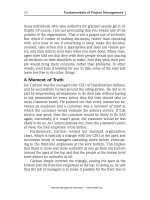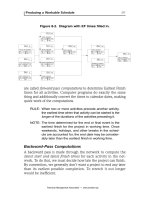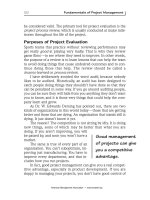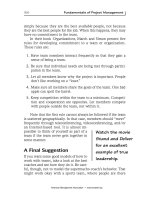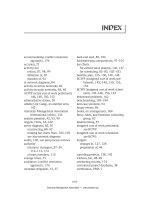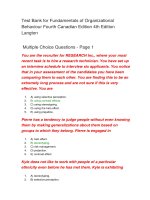Fundamentals of organizational behavior 2e by dubrin ch10
Bạn đang xem bản rút gọn của tài liệu. Xem và tải ngay bản đầy đủ của tài liệu tại đây (630.63 KB, 35 trang )
Leadership in Organizations
Chapter
10
Fundamentals of
Organizational Behavior 2e
Andrew J. DuBrin
PowerPoint Presentation
by Charlie Cook
Learning Objectives
1. Differentiate between leadership and management.
2. Describe key leadership traits, styles, and behaviors.
3. Explain the basics of four different contingency
theories of leadership.
4. Present an overview of transformational and
charismatic leadership.
5. Explain how 360-degree feedback is used to improve
leadership effectiveness.
6. Identify gender differences in leadership style.
7. Identify forces that can sometimes decrease the
importance of leadership.
A. J. DuBrin, Fundamentals of Organizational
10–2
The Nature of Leadership
Leadership
Is defined as the ability inspire confidence and
support among the people on whose competence
and commitment performance depends.
Involves influencing others to achieve objectives
important to them and the organization.
Contributes to organizational effectiveness through
the use of desirable personal attributes to achieve
good results.
Effective Leadership = Attributes x Results
A. J. DuBrin, Fundamentals of Organizational
10–3
Leaders versus Managers
Leaders
Managers
Visionary
Rational
Passionate
Consulting
Creative
Persistent
Flexible
Problem-solving
Inspiring
Tough-minded
Innovative
Analytical
Courageous
Structured
Imaginative
Deliberate
Experimental
Authoritative
Independent
A. J. DuBrin, Fundamentals of Organizational
Stabilizing
10–4
Leadership Traits and Characteristics
Cognitive Skills
Personality Traits
Mental abilities and
Enthusiasm
knowledge
Problem-solving skills
Imagination, creativity, and
a willingness to
experiment
Technical and professional
competence (knowledge of
the business)
Self-confidence
Trustworthiness
Emotional intelligence
Needs for power and
achievement
A sense of humor
A. J. DuBrin, Fundamentals of Organizational
10–5
Leadership Styles and Behavior
Behavioral Approach to Leadership
Attempts to specify how the behaviors of effective leaders
differ from less-effective leaders.
Based on the assumption that leaders are relatively
consistent in how they attempt to influence group
members.
Key concept is “leadership style”—the relatively
consistent pattern of behavior that characterizes a leader.
Recognizes that some
leaders modify their
leadership style as
the situation requires.
A. J. DuBrin, Fundamentals of Organizational
10–6
Pioneering Studies on Leadership
Dimensions
Ohio State University
Ohio State University
Initiating structure
The
degree to which the leader establishes structure for group
members: assigning task, specifying procedures, scheduling
work, and clarifying expectations.
Consideration
The
degree to which the leader creates an environment of
emotional support, warmth, friendliness, and trust.
Research findings
Leaders
high on initiating structure were rated highly and had
higher-producing work groups.
High consideration in leaders is associated with low turnover
and high job satisfaction.
A. J. DuBrin, Fundamentals of Organizational
10–7
High
Initiating Structure
Leadership Styles
Based on a
Combination
of Initiating
Structure
and
Consideration
Low structure
and
high consideration
High structure
and
high consideration
Low structure
and
low consideration
High structure
and
low consideration
Low
High
Low
EXHIBIT
10-2
Initiating Structure
A. J. DuBrin, Fundamentals of Organizational
10–8
Pioneering Studies on Leadership
Dimensions
University of Michigan
Production-centered managers
Set
tight work standards, organized tasks carefully,
prescribed work methods, and supervised closely.
Employee-centered managers
Encouraged
participative goal setting and decisionmaking, fostered high performance by engendering trust
and mutual respect.
A. J. DuBrin, Fundamentals of Organizational
10–9
Pioneering Studies on Leadership
Dimensions
University of Michigan
Findings
Employee-centered
managers had the most productive
work groups.
The most effective leaders had supportive relationships
with employees, used group decision making, and
encouraged employee goal setting.
A. J. DuBrin, Fundamentals of Organizational
10–10
Managing Polarities
Peter Koestenbaum on Leadership
The central attribute of
leadership is the ability
to manage polarity—
extremes of positions
and interests.
A. J. DuBrin, Fundamentals of Organizational
10–11
The Leadership Grid
The Leadership Grid©
Describes leadership style in term of concerns for
production and people. These concerns reflect attitudes
rather than actual behavior.
Concern for production includes results, bottom-line
performance, profits, and mission.
Concern for people includes group members and coworkers.
Grid assumes that an opportunistic leader shifts to any Grid
style to achieve personal gain and self-promotion.
Best style is team management — at 9,9 on the Grid (high
concern for both production and people).
A. J. DuBrin, Fundamentals of Organizational
10–12
The Leadership High9
Grid Figure*
8
Concern for Results
7
* Formerly the Managerial Grid by
Robert R. Blake and Jane S. Mouton.
Source: Robert R. Blake and Anne
Adams McCarse, Leadership
Dukennas—Grid Solutions, Houston:
Gulf Publishing Company, Grid figure:
p. 29, Paternalism/ Materialism figure:
p. 30, Opportunism figure: p. 31.
Copyright © 1991 by Scientific
Methods, Inc. Reproduced by
permission of the owners.
EXHIBIT
10-3a
1,9
9,9
Team Management:
Work accomplishment is from
committed people; interdependence
through a "common stake" in
organization purpose leads to
relationships of trust and respect.
Country Club Management:
Thoughtful attention to the needs of
the people for satisfying relationships
leads to a comfortable, friendly
organization atmosphere and work
tempo.
6
Middle of the Road Management:
5,5
5
Adequate organization performance is possible through
balancing the necessity to get work out while maintaining
morale of people at a satisfactory level.
4
3
2
1
Low
Authority-Compliance Management:
Efficiency in operations results from
arranging conditions of work in such a
way that human elements interfere to a
minimum degree.
Impoverished Management:
Exertion of minimum effort to get
required work done is appropriate to
sustain organization membership.
1,1
1
Low
9,1
2
3
4
5
6
Concern for Results
A. J. DuBrin, Fundamentals of Organizational
7
8
9
®
High
10–13
The Leadership Grid Figure*
9 + 9 Paternalism/Maternalism
Opportunism
1,9
9,9
5,5
Rewards and approval are bestowed to
1,9
people in return for loyalty and obedience;
9+ 9
failure to comply leads to punishment.
9,1
1,9
9, 1
1,1
In Opportunistic Management, people adapt and shift to any Grid
9+ 9
style needed to gain the maximum advantage. Performance occurs
according to a system of selfish gain. Effort is given only for an
advantage for personal gain.
9,1
*Formerly the Managerial Grid by Robert R. Blake and Jane S. Mouton.
EXHIBIT
10-3b
Source: Robert R. Blake and Anne Adams McCarse, Leadership Dukennas—Grid
Solutions, Houston: Gulf Publishing Company, Grid figure: p. 29, Paternalism/Materialism
figure: p. 30, Opportunism figure: p. 31. Copyright © 1991 by Scientific Methods, Inc.
Reproduced by permission of the owners.
A. J. DuBrin, Fundamentals of Organizational
10–14
The Leader-Member Exchange Model
Leaders do not relate to each group member in the same
manner.
Leaders develop unique working relationships with
each group member.
In-groups
are given additional rewards, responsibilities,
and trust in exchange for their loyalty and performance.
Out-groups have a more formal (traditional) superiorsubordinate relationship with the leader.
Research findings
In-group
membership is beneficial to its members.
High-quality leader-member exchanges improve delegation.
Supervisors are not overly influenced by the exchanges.
A. J. DuBrin, Fundamentals of Organizational
10–15
Contingency Theories of Leadership
Fiedler’s Contingency Theory of Leadership
Assumes that the best style of leadership is
determined by the situation in which the leader is
working.
Uses the least-preferred coworker (LPC) scale to
measure the leader’s style.
LPC
is a measure of how a manager describes his or her
relationship to a referent (least-preferred) coworker.
Positive LPC descriptions indicate relationship-oriented
management styles.
Negative LPC descriptions indicate task-oriented
management styles.
A. J. DuBrin, Fundamentals of Organizational
10–16
Contingency Theories of Leadership
Fiedler’s Contingency Theory of Leadership
Situational control
Is
the degree to which the leader can control and influence
the outcomes of group effort.
Measurements of situational control are based on:
Leader-member
relations (good to bad)
Task structure (well to ill-defined)
Position power (leader’s ability to reward and control)
A. J. DuBrin, Fundamentals of Organizational
10–17
Summary of Findings from
Fiedler’s Contingency Theory
Task-motivated and
socio-independent leaders
perform best when they
have the most control
(highly favorable).
High
Relationship-motivated
leaders perform best
when they have moderate
control (moderately
favorable).
Moderate
Task-motivated leaders
perform best when they
have low control (highly
unfavorable).
Low
AMOUNT OF SITUATIONAL CONTROL BY LEADER
a. Leader-member
relations are good.
b. Task is well structured.
c. Leader has high
position power.
EXHIBIT
10-4
A combination of
favorable and unfavorable
factors.
a. Leader-member relations
are poor.
b. Task is poorly structured.
c. Leader has low position
power.
A. J. DuBrin, Fundamentals of Organizational
10–18
Contingency Theories of Leadership
Fiedler’s Contingency Theory of Leadership
Research findings
Task-motivated
style is best when the leader has very high
or very low control of the situation.
Relationship-motivated style best in situation under
moderate or intermediate control.
Socio-independent leaders function best when control is
high.
A. J. DuBrin, Fundamentals of Organizational
10–19
Contingency Theories of Leadership
The Path-Goal Theory of Leadership
Specifies what a leader must do to achieve high
morale and productivity in a given situation.
Focuses on helping employees find the right path to
goal attainment.
Assumes that the leader will choose the right
leadership style to match the contingencies of a
particular situation.
Is based on expectancy theory in that its key
propositions relate to motivation, satisfaction, and
performance.
A. J. DuBrin, Fundamentals of Organizational
10–20
Contingency Theories of Leadership
The Path-Goal Theory of Leadership
Choices for adjusting leadership styles to meet
situational contingency demands:
Directive
Initia ting struc ture, se tting g uidelines a nd sta ndar ds,
and convey ing expectatio ns.
Supportive
Em phasizes sho wing co ncern for the well being of
group m em bers and developing m utua lly satisfy ing
relations hips.
Partic ipative
Involves cons ulting with group m em bers and us ing
their inp ut into the decisio n m aking process.
A chievement-oriented
Leader sets challe nging goals, promotes work
im provement, se ts hig h expectations and expects
group m em bers to act responsibly .
A. J. DuBrin, Fundamentals of Organizational
10–21
The Path-Goal Theory of Leadership
(Contingency factors)
Personal
characteristics
of group members
Leadership Styles
OUTCOMES
Directive
Supportive
Participative
Achievement-oriented
Productivity
Morale
Demands of
the Task
EXHIBIT
10-5
(Contingency factors)
A. J. DuBrin, Fundamentals of Organizational
10–22
Contingency Relationships
in Path-Goal Leadership
Leadership Style
Situation in which Appropriate
Directive
Positively affects satisfaction and expectancies of subordinates
working on ambiguoustasks.
Negatively affects satisfaction and expectancies of subordinates
working on clearly defined tasks.
Supportive
Positively affects satisfaction of subordinates working on dissatisfying, stressful, or frustrating tasks.
Participative
Positively affects satisfaction of subordinates who are ego-involved
with nonrepetitive tasks.
Achievement-oriented
Positively affects confidence that effort will lead to effective performance of subordinates working on ambiguousand nonrepetitive
tasks.
EXHIBIT
10-6
A. J. DuBrin, Fundamentals of Organizational
10–23
Contingency Theories of Leadership
The Situational Leadership Model
Explains how a leader chooses a leadership style that
is appropriate to the readiness of group members.
Readiness is defined as the extent to which a group
member has the ability and willingness or
confidence to accomplish a task.
As the readiness of group members
increases, a leader should rely more
on relationship-related leadership
behaviors and less on task-related
leadership behaviors.
A. J. DuBrin, Fundamentals of Organizational
10–24
The Situational
Model of
Leadership
Situational Leadership® is a registered
trademark of the Center for Leadership
Studies. Reprinted with the permission of
the Center for Leadership Studies,
Escondido, CA 92025. All rights reserved.
EXHIBIT
10-7
A. J. DuBrin, Fundamentals of Organizational
10–25

